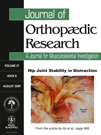No efficacy of silver bone cement in the prevention of methicillin-sensitive Staphylococcal infections in a rabbit contaminated implant bed model
Abstract
Data from literature showed that a new type of metallic silver PMMA cement had good results in infection prophylaxis. This study investigated the in vivo efficacy of silver cement in the prevention of methicillin-sensitive Staphylococcal infections, compared to plain and tobramycin-containing cement. In 48 rabbits, 0.6% silver, 1% silver, plain, or tobramycin PMMA cement was injected into the femoral medullary canal after contamination with 105, 106, or 107 colony forming units (CFU) Staphylococcus aureus. After 14 days, bone was collected for bacteriology and histopathology. All plain and silver cement rabbits were infected, whereas only two tobra rabbits were infected (p < 0.001). The number of bacteria cultured (10logCFU) from bone adjacent to the cement, was 6.4 ± 0.3 and 6.1 ± 0.3 for the 0.6% and 1% silver rabbits. For the rabbits with plain and tobra cement, this was 6.2 ± 0.2 (p > 0.95) and 0.0 ± 0.0 (p < 0.001), respectively. Two tobra rabbits had a positive culture of a distal bone sample. Histological sections of plain, 0.6%, and 1% silver rabbits all showed signs of infection; these signs were absent in the tobra rabbits. Silver and plain cement were not effective in preventing infection, whereas tobra cement was effective. As silver cement predominantly exhibits an antimicrobial effect at the direct cement surface, this cement seems less useful in situations where there are bacteria present in surrounding tissues, like revision surgery. Whether silver cement has relevance in the prevention of bacterial colonization of cement remains to be determined. © 2009 Orthopaedic Research Society. Published by Wiley Periodicals, Inc. J Orthop Res 27: 1002–1007, 2009




